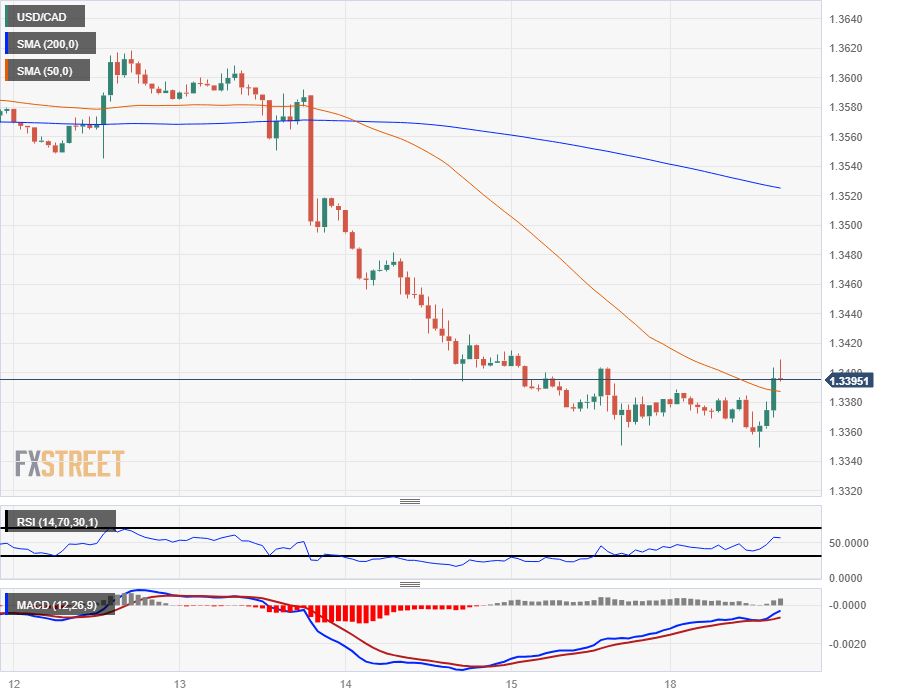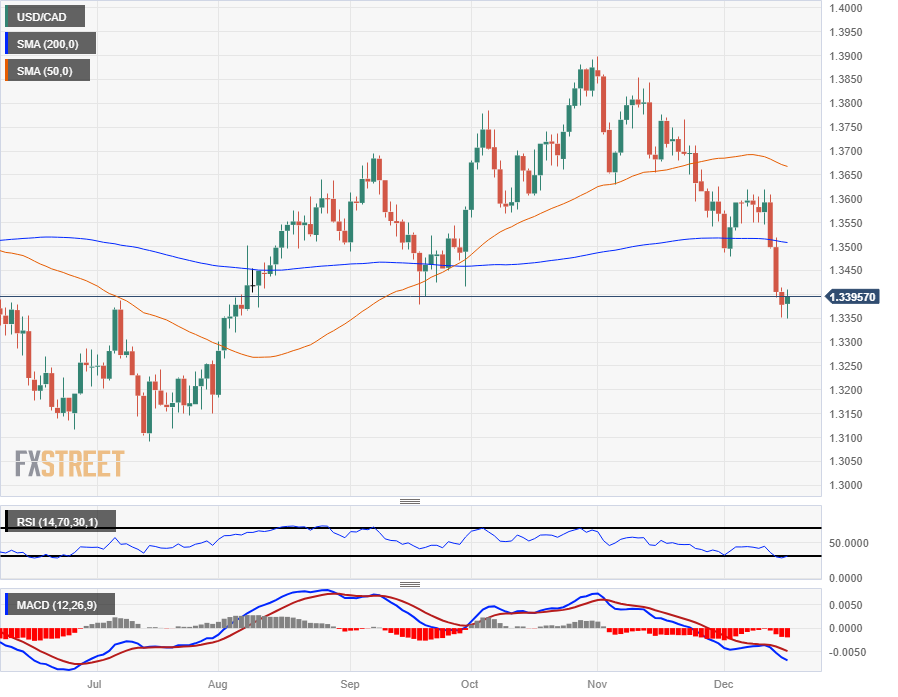- The Canadian dollar trims some of last Friday’s gains ahead of Tuesday’s Canadian CPI.
- Monday’s economic agenda is limited, but key data to close 2023 will be published this week.
- CAD and crude oil price diverge, while WTI regains ground on Monday.
The Canadian Dollar (CAD) retreats at the start of the last two trading weeks of 2023, with the final Canadian Consumer Price Index (CPI) inflation figure on Tuesday’s economic agenda.
The Bank of Canada (BoC) will release its latest summary of deliberations on Wednesday, in addition to reporting its own version of the Canadian CPI. Thursday’s Canadian Retail Sales and Friday’s Canadian Gross Domestic Product (GDP) will be overshadowed by the heavier US counterpart data.
Daily Market Summary: Canadian Dollar Prepares, Awaits Latest 2023 Inflation Figure
- The CAD retreats slightly on Monday, falling or flattening against almost all other major currencies.
- The Canadian Dollar fell 0.10% against the US Dollar (USD), but rose 0.4% against the Japanese Yen (JPY), as the Yen outperformed the Canadian Dollar to become the weakest currency on Monday.
- Tuesday’s Canadian Consumer Price Index inflation is expected to show a further cooling of consumer prices, with a year-over-year decline forecast from 3.1% to 2.9%. November’s month-on-month CPI is also expected to cool again, falling to -0.2% from 0.1% in October.
- The summary of the BoC deliberations is scheduled for Wednesday, but is unlikely to reveal much new information that has not already been discussed extensively by BoC Governor Tiff Macklem at last Friday’s conference.
- Macklem said it is still too early to consider a cut in our monetary policy rate
- Thursday’s October Canadian Retail Sales is forecast to improve to 0.8% from 0.6% seen in September, and Friday’s Canadian Gross Domestic Product rounds out the business year with a bullish expectation of 0.2% in October from 0.1%. of September.
Quote of the Canadian Dollar today
Below is the percentage change of the Canadian Dollar (CAD) against major currencies today.
| USD | EUR | GBP | CAD | AUD | JPY | NZD | CHF | |
| USD | -0.24% | 0.34% | 0.09% | 0.03% | 0.49% | 0.06% | -0.30% | |
| EUR | 0.22% | 0.54% | 0.34% | 0.27% | 0.74% | 0.30% | -0.06% | |
| GBP | -0.30% | -0.54% | -0.22% | -0.27% | 0.19% | -0.25% | -0.60% | |
| CAD | -0.10% | -0.34% | 0.20% | -0.07% | 0.40% | -0.04% | -0.39% | |
| AUD | -0.03% | -0.27% | 0.31% | 0.07% | 0.46% | 0.03% | -0.32% | |
| JPY | -0.49% | -0.72% | -0.16% | -0.40% | -0.48% | -0.42% | -0.79% | |
| NZD | -0.07% | -0.30% | 0.24% | 0.04% | -0.04% | 0.43% | -0.36% | |
| CHF | 0.29% | 0.06% | 0.60% | 0.38% | 0.32% | 0.79% | 0.35% |
The heat map shows the percentage changes of the major currencies against each other. The base currency is chosen in the left column, while the quote currency is chosen in the top row. For example, if you choose the euro in the left column and scroll down the horizontal line to the Japanese yen, the percentage change in the box will represent EUR (base)/JPY (quote).
Technical Analysis: Monday’s Canadian Dollar pause could give way to a full-blown pullback if USD bulls catch CAD bulls with their pants down
On Monday, the Canadian Dollar retreated to 1.3400 against the US Dollar, in a slight reversal of recent bullish momentum. Last week, after three days of bullish moves in the Canadian Dollar, the USD/CAD pair hit multi-month lows near 1.3350, after falling from last week’s highs near the 1.3600 area.
The pair has fallen more than 3.5% from highs reached in early November just below 1.3900, but the break of the 200-day SMA near 1.3500 last week could see USD/CAD primed for a setback.
If CAD comps do not make a significant comeback to push the pair back to the 2023 lows near 1.3100, the boundary of a bullish rebound in the US Dollar may not be firm until the pair returns to the SMA of 50 days with slope at 1.3650.
USD/CAD 1-hour chart
USD/CAD daily chart
Frequently Asked Questions about the Canadian Dollar
What factors determine the price of the Canadian dollar?
The key factors that determine the price of the Canadian dollar (CAD) are the level of interest rates set by the Bank of Canada (BoC), the price of oil, Canada’s main export product, the health of its economy, inflation and the trade balance, which is the difference between the value of Canadian exports and its imports. Other factors are market confidence, that is, whether investors bet on riskier assets (risk-on) or look for safe assets (risk-off), with the risk-on being positive for the CAD. As its largest trading partner, the health of the US economy is also a key factor influencing the Canadian dollar.
How do Bank of Canada decisions affect the Canadian dollar?
The Bank of Canada (BoC) exerts significant influence over the Canadian Dollar by setting the level of interest rates that banks can lend to each other. This influences the level of interest rates for everyone. The BoC’s main objective is to keep inflation between 1% and 3% by adjusting interest rates up or down. Relatively high interest rates are usually positive for the CAD. The Bank of Canada can also use quantitative easing and tightening to influence credit conditions, with the former being negative for the CAD and the latter being positive for the CAD.
How does the price of oil affect the Canadian dollar?
The price of oil is a key factor influencing the value of the Canadian Dollar. Oil is Canada’s largest export, so the price of oil tends to have an immediate impact on the value of the CAD. Generally, if the price of oil rises, the CAD also rises, as aggregate demand for the currency increases. The opposite occurs if the price of oil falls. Higher oil prices also tend to lead to a higher probability of a positive trade balance, which also supports the CAD.
How does inflation data influence the value of the Canadian Dollar?
Although inflation has traditionally always been considered a negative factor for a currency, as it reduces the value of money, the opposite has actually happened in modern times, with the relaxation of cross-border capital controls. Higher inflation often leads central banks to raise interest rates, attracting more capital inflows from global investors looking for a lucrative place to store their money. This increases the demand for the local currency, which in the case of Canada is the Canadian Dollar.
How does economic data influence the value of the Canadian dollar?
The published macroeconomic data measures the health of the economy and may have an impact on the Canadian dollar. Indicators such as GDP, manufacturing and services PMIs, employment and consumer confidence surveys can influence the direction of the CAD. A strong economy is good for the Canadian dollar. Not only does it attract more foreign investment, but it may encourage the Bank of Canada to raise interest rates, resulting in a stronger currency. However, if economic data is weak, the CAD is likely to fall.
Source: Fx Street
I am Joshua Winder, a senior-level journalist and editor at World Stock Market. I specialize in covering news related to the stock market and economic trends. With more than 8 years of experience in this field, I have become an expert in financial reporting.









